Mastering Stop-Loss Placement: A Guide to Profitability in Forex Trading August 19, 2025

Effective stop-loss placement is a cornerstone of prudent risk management in forex trading. It’s not merely about cutting losses, but about preserving capital and allowing profitable trades to run their course. While the concept is simple, the art of setting an optimal stop-loss lies in understanding market dynamics and leveraging the power of technical indicators.
This guide explores several key indicators, demonstrating how they can provide valuable insights for strategic stop-loss placement, with practical examples drawn from the forex market.
The Indispensable Role of Stop-Loss Orders
Before diving into indicators, it’s crucial to reiterate why stop-loss orders are non-negotiable. They act as a predetermined exit point for a trade, limiting potential losses if the market moves against your position. Without a stop-loss, a single adverse market movement can wipe out a significant portion of your trading capital.
By setting a stop-loss, you define your maximum acceptable risk per trade, fostering disciplined trading habits and protecting your portfolio from catastrophic downturns.
Leveraging Technical Indicators for Precision Stop-Loss Placement
Various technical indicators offer distinct advantages in identifying logical and effective stop-loss levels. Here’s how you can integrate them into your risk management strategy:
1. Average True Range (ATR): Adapting to Volatility
Volatility is a constant in the forex market, and a static stop-loss often proves ineffective. The Average True Range (ATR) indicator addresses this by measuring market volatility over a specified period, typically 14 days. It provides an average of the true range (the largest of the current high minus the current low, current high minus previous close, or current low minus previous close), offering a dynamic measure of price fluctuations.
How to Use ATR for Stop-Loss:
- Dynamic Placement: Instead of a fixed number of pips, ATR allows you to set a stop-loss that adapts to the current market environment. In highly volatile conditions, the ATR value will be higher, leading to a wider stop-loss, giving the trade more room to breathe. Conversely, in low-volatility environments, the ATR will be smaller, resulting in a tighter stop-loss.
- Multiplier Method: A common practice is to place your stop-loss at a multiple of the current ATR value. For instance, placing a stop-loss at 1.5 or 2 times the current ATR below your entry point for a long trade, or above your entry for a short trade. This ensures that your stop-loss is placed beyond the typical noise and daily fluctuations, reducing the likelihood of being stopped out prematurely due to minor market jitters.
- Example (EUR/USD): If you enter a long EUR/USD trade and the 14-period ATR is 0.0093 (93 pips), setting your stop-loss at 2x ATR would mean placing it 186 pips below your entry. This accounts for the pair’s typical movement and provides a buffer against daily swings.
 Source: www.tradingview.com
Source: www.tradingview.com
2. Parabolic SAR: Trailing Your Profits and Limiting Losses
The Parabolic SAR (Stop and Reverse) is a trend-following indicator that produces a series of dots either above or below the price action. It serves as an excellent trailing stop-loss mechanism, allowing traders to lock in profits as a trend develops while simultaneously protecting against reversals.
How to Use Parabolic SAR for Stop-Loss:
- Dynamic Trailing Stop: When the price is in an uptrend, the Parabolic SAR dots are below the price, continuously moving upwards, trailing the price. In a downtrend, the dots are above the price, moving downwards.
- Trend Reversal Signal: The beauty of the Parabolic SAR is its “stop and reverse” nature. When the dots flip to the opposite side of the price (e.g., from below to above in an uptrend), it signals a potential trend reversal and acts as an immediate exit point for your current trade, often prompting a reversal of your position.
- Placement Strategy: For a long trade, your stop-loss would be placed at the current level of the Parabolic SAR dot. As the trend progresses, the dot moves closer to the price, effectively trailing your stop-loss and protecting accumulated profits.
- Example (GBP/USD): If you are long on GBP/USD and the Parabolic SAR dots are steadily rising below the price, you would adjust your stop-loss to the level of the most recent dot. If the dots suddenly appear above the price, it indicates a potential downtrend and your stop-loss is triggered, exiting the long position.
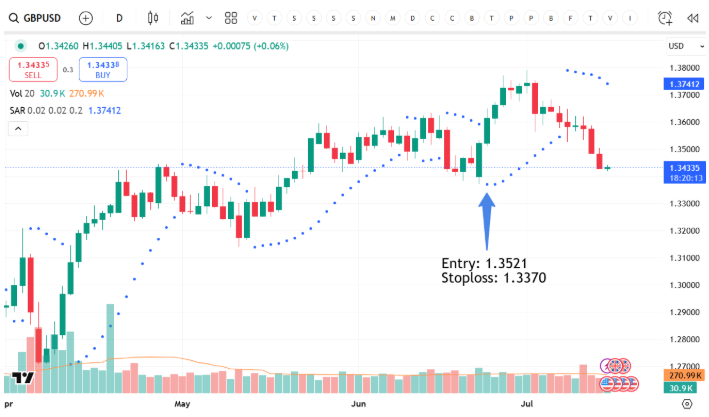 Source: www.tradingview.com
Source: www.tradingview.com
3. Moving Averages: Dynamic Support and Resistance
Moving Averages (MAs) are widely used for identifying trend direction and potential support/resistance levels. They can also serve as powerful dynamic stop-loss indicators. Common moving averages include the 20-period, 50-period, 100-period, and 200-period MAs.
How to Use Moving Averages for Stop-Loss:
- Support/Resistance Proxies: In an uptrend, shorter-period moving averages (e.g., 20-period or 50-period) often act as dynamic support levels. For a long trade, placing your stop-loss just below these moving averages can protect against minor pullbacks. Conversely, in a downtrend, MAs act as dynamic resistance. For a short trade, a stop-loss would be placed just above these MAs.
- Trend Confirmation: A decisive break and close beyond a significant moving average can indicate a shift in the underlying trend or momentum. If the price breaks significantly through your chosen moving average, it suggests that your initial trade premise may be invalidated, prompting an exit.
- Combination with Other Indicators: MAs are even more effective when combined with other indicators or price action analysis. For example, if a candlestick pattern forms a rejection off a moving average, it strengthens the case for using that MA as a stop-loss level.
- Example (AUD/USD): You enter a long AUD/USD trade as the price bounces off its 50-period Simple Moving Average (SMA). You could place your stop-loss a few pips below the 100-period SMA. If the price then breaks and closes below the 100-period SMA, it signals weakness and your stop-loss would be triggered. Doing so also gives your trade some breathing room. As a swing trader with a full time job, such daily trades can make our money work harder and it only takes 10 minutes a day to look through the charts.
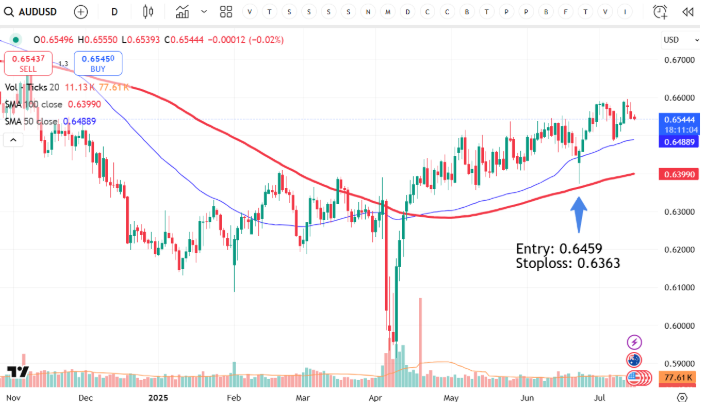 Source: www.tradingview.com
Source: www.tradingview.com
4. Fibonacci Retracement Levels: Identifying Potential Reversal Zones
Fibonacci retracement levels are derived from the Fibonacci sequence and are used to identify potential areas of support and resistance during a price pullback. The key levels are 23.6%, 38.2%, 50%, 61.8%, and 78.6%.
How to Use Fibonacci Retracement for Stop-Loss:
- Beyond Retracement Points: When a price is correcting within a trend, traders often look for entry points at key Fibonacci retracement levels. Accordingly, a stop-loss can be placed just beyond the next significant Fibonacci level in the direction of the correction. For instance, if you enter a long trade at the 38.2% retracement, your stop-loss might be placed just below the 50% retracement level.
- Confluence with Other Levels: Fibonacci levels gain considerable strength when they align with other forms of support/resistance, such as previous swing highs/lows or moving averages. This confluence suggests a stronger likelihood of a price reversal or continuation, making them ideal areas for stop-loss placement.
- Example (USD/CAD): After a strong bearish move, USD/CAD pulls back to the 50% Fibonacci retracement level. If you anticipate the trend to resume and enter a short position, you might place your stop-loss just below the 61.8% retracement level, providing a buffer against pullbacks.
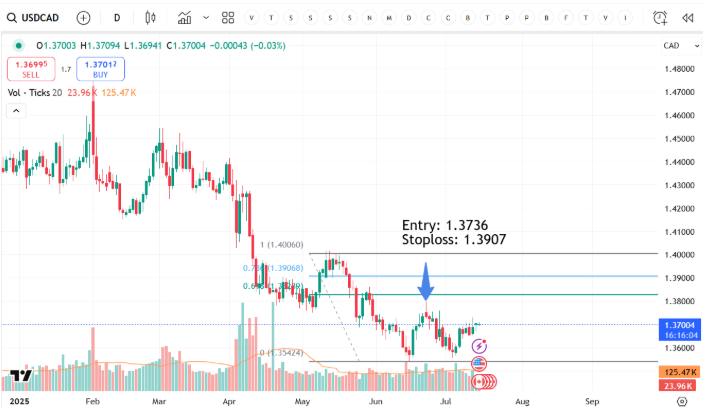 Source: www.tradingview.com
Source: www.tradingview.com
Conclusion
Regardless of the indicator you choose. Remember to be consistent. If you change your strategy or indicator each time you get stopped out, the results will also be inconsistent.
Forex trading is a low barrier to entry for technical traders. It is an ideal product to start getting your feet wet and hone your technical skills. Finally, I’d like to share a list of Forex pairs with you to kickstart your trading journey.
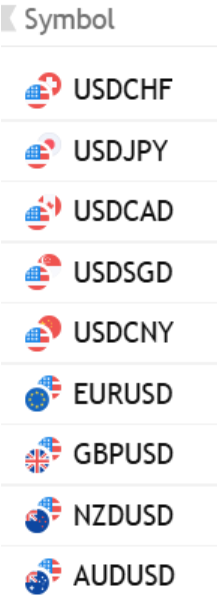 Source: www.tradingview.com
Source: www.tradingview.com
With the right tools, you will greatly reduce the frequency of being stopped out in a trade, therefore increase your odds to become a profitable trader.
How to get started with POEMS
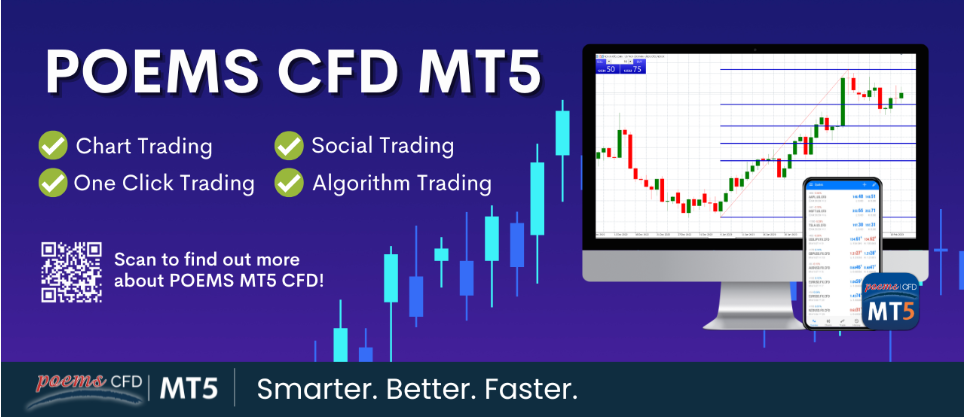 Source: www.tradingview.com
Source: www.tradingview.com
POEMS award-winning trading platforms now bring you MetaTrader 5 (MT5), offering traders with advanced tools and seamless access to CFDs on shares, forex, indices, commodities, and more.
Unlock superior trading capabilities with over 80 technical indicators, customisable charts, and algorithmic trading features. Whether you’re new to trading or a seasoned investor, MT5 equips you with the tools to capitalise on market opportunities.
Open Your POEMS CFD MT5 Account Today
To start trading on POEMS CFD MT5, you’ll need an existing POEMS account. If you don’t have one yet, sign up for a POEMS account now to unlock the gateway to seamless CFD trading on MT5.
Take advantage of the flexibility to trade CFDs on global markets with leverage, enabling you to diversify your portfolio and maximise trading potential anytime and anywhere.
For enquiries, please email us at cfd@phillip.com.sg.
Disclaimer
These commentaries are intended for general circulation and do not have regard to the specific investment objectives, financial situation and particular needs of any person. Accordingly, no warranty whatsoever is given and no liability whatsoever is accepted for any loss arising whether directly or indirectly as a result of any person acting based on this information. You should seek advice from a financial adviser regarding the suitability of any investment product(s) mentioned herein, taking into account your specific investment objectives, financial situation or particular needs, before making a commitment to invest in such products.
Opinions expressed in these commentaries are subject to change without notice. Investments are subject to investment risks including the possible loss of the principal amount invested. The value of units in any fund and the income from them may fall as well as rise. Past performance figures as well as any projection or forecast used in these commentaries are not necessarily indicative of future or likely performance.
Phillip Securities Pte Ltd (PSPL), its directors, connected persons or employees may from time to time have an interest in the financial instruments mentioned in these commentaries.
The information contained in these commentaries has been obtained from public sources which PSPL has no reason to believe are unreliable and any analysis, forecasts, projections, expectations and opinions (collectively the “Research”) contained in these commentaries are based on such information and are expressions of belief only. PSPL has not verified this information and no representation or warranty, express or implied, is made that such information or Research is accurate, complete or verified or should be relied upon as such. Any such information or Research contained in these commentaries are subject to change, and PSPL shall not have any responsibility to maintain the information or Research made available or to supply any corrections, updates or releases in connection therewith. In no event will PSPL be liable for any special, indirect, incidental or consequential damages which may be incurred from the use of the information or Research made available, even if it has been advised of the possibility of such damages. The companies and their employees mentioned in these commentaries cannot be held liable for any errors, inaccuracies and/or omissions howsoever caused. Any opinion or advice herein is made on a general basis and is subject to change without notice. The information provided in these commentaries may contain optimistic statements regarding future events or future financial performance of countries, markets or companies. You must make your own financial assessment of the relevance, accuracy and adequacy of the information provided in these commentaries.
Views and any strategies described in these commentaries may not be suitable for all investors. Opinions expressed herein may differ from the opinions expressed by other units of PSPL or its connected persons and associates. Any reference to or discussion of investment products or commodities in these commentaries is purely for illustrative purposes only and must not be construed as a recommendation, an offer or solicitation for the subscription, purchase or sale of the investment products or commodities mentioned.
This advertisement has not been reviewed by the Monetary Authority of Singapore.
CFD Disclaimer
This promotion is provided to you for general information only and does not constitute a recommendation, an offer or solicitation to buy or sell the investment product mentioned. It does not have any regard to your specific investment objectives, financial situation or any of your particular needs. Accordingly, no warranty whatsoever is given and no liability whatsoever is accepted for any loss arising whether directly or indirectly as a result of your acting based on this information.
Investments are subject to investment risks. The risk of loss in leveraged trading can be substantial. You may sustain losses in excess of your initial funds and may be called upon to deposit additional margin funds at short notice. If the required funds are not provided within the prescribed time, your positions may be liquidated. The resulting deficits in your account are subject to penalty charges. The value of investments denominated in foreign currencies may diminish or increase due to changes in the rates of exchange. You should also be aware of the commissions and finance costs involved in trading leveraged products. This product may not be suitable for clients whose investment objective is preservation of capital and/or whose risk tolerance is low. Clients are advised to understand the nature and risks involved in margin trading.
You may wish to obtain advice from a qualified financial adviser, pursuant to a separate engagement, before making a commitment to purchase any of the investment products mentioned herein. In the event that you choose not to obtain advice from a qualified financial adviser, you should assess and consider whether the investment product is suitable for you before proceeding to invest and we do not offer any advice in this regard unless mandated to do so by way of a separate engagement. You are advised to read the trading account Terms & Conditions and Risk Disclosure Statement (available online at https://www.poems.com.sg/) before trading in this product.
About the author
Chua Minghan
Head, HQ Dealing Team
Chua Minghan graduated from the National University of Singapore with a Bachelor’s degree in Economics. He is passionate about education and went on to get a post-grad Diploma in teaching. His vision is to educate clients to make informed decisions for their trading and investments.
Minghan enjoys learning fundamental analysis, technical analysis, and strives to use data analysis to improve his trading skills.

 Crude Realities: Understanding oil prices and how to trade them
Crude Realities: Understanding oil prices and how to trade them  Gold at All-Time Highs: What’s Fuelling the 2025 Rally?
Gold at All-Time Highs: What’s Fuelling the 2025 Rally?  Salesforce: A Steady Tech Leader in Volatile Times
Salesforce: A Steady Tech Leader in Volatile Times  Understanding Supply and Demand Key to Profitable Forex Trading
Understanding Supply and Demand Key to Profitable Forex Trading 




